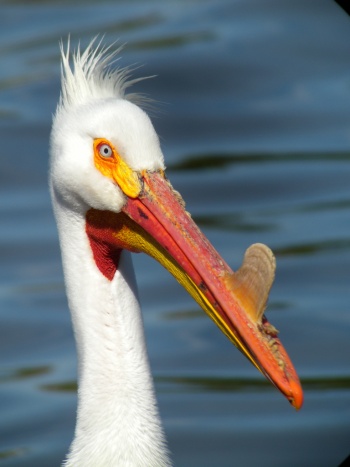- Pelecanus erythrorhynchos
Identification
Length 127-178 cm, wingspan 240-300 cm, weight 5-8.5 kg.
- A huge white bird
- Long flat orange-yellow bill (flushed red during courtship display) with elastic pouch from the throat to the lower mandible which expands when filled, orange legs.
- Black primary and secondary feathers.
Breeding: has short yellowish crest on back of head and an erect horny plate on upper mandible.
At the end of the breeding season they undergo a few changes to the breeding plumage appearance. The "horn" on the upper mandible is lost, and many birds show short gray feathers on the crown and nape, which is described as "supplemental" plumage.
Juvenile duskier gray-brown than adults.
Distribution
Breeds from interior British Columbia and Mackenzie south to northern California, Utah, and Manitoba; also along Texas Gulf Coast. Winters from central California, Gulf Coast, and Florida south to Panama.
Annual vagrant to most states in the northeast and along the east coast.
Taxonomy
This is a monotypic species[1].
Habitat
Shallow freshwater lakes and marshes; also uses islets in saline lakes for breeding. In winter also on coastal lagoons and brackish ponds.
Behaviour
Diet
They work cooperatively in small groups, herding fish into shallow water and then scooping them up in their gigantic pouches.
Breeding
They lay 1-6 (most often 2) whitish eggs on a low mound of earth and debris on a marshy island; occasionally on rocky islands in desert lakes. Nests in colonies.
The plate-like growth(s) on the upper mandible are shed after the eggs are laid.
Vocalisation
They are mostly silent but will make croaking noises on the breeding grounds.
Movements
Regular North–South migration; all migration over land, at times over deserts or mountains.

Photo © by blubird
Lake Merritt, Oakland, California, U.S., 3 April 2011
References
- Clements, J. F., P. C. Rasmussen, T. S. Schulenberg, M. J. Iliff, T. A. Fredericks, J. A. Gerbracht, D. Lepage, A. Spencer, S. M. Billerman, B. L. Sullivan, M. Smith, and C. L. Wood. 2024. The eBird/Clements checklist of Birds of the World: v2024. Downloaded from https://www.birds.cornell.edu/clementschecklist/download/
- Del Hoyo, J, A Elliot, and J Sargatal, eds. 1992. Handbook of the Birds of the World. Volume 1: Ostrich to Ducks. Barcelona: Lynx Edicions. ISBN 978-8487334108
- Knopf, F. L. and R. M. Evans (2004). American White Pelican (Pelecanus erythrorhynchos), version 2.0. In The Birds of North America (A. F. Poole, Editor). Cornell Lab of Ornithology, Ithaca, NY, USA. https://doi.org/10.2173/bna.57
- Elliott, A., Christie, D.A., Jutglar, F., Garcia, E.F.J. & Kirwan, G.M. (2020). American White Pelican (Pelecanus erythrorhynchos). In: del Hoyo, J., Elliott, A., Sargatal, J., Christie, D.A. & de Juana, E. (eds.). Handbook of the Birds of the World Alive. Lynx Edicions, Barcelona. (retrieved from https://www.hbw.com/node/52615 on 4 March 2020).
Recommended Citation
- BirdForum Opus contributors. (2025) American White Pelican. In: BirdForum, the forum for wild birds and birding. Retrieved 16 May 2025 from https://www.birdforum.net/opus/American_White_Pelican
External Links
GSearch checked for 2020 platform.1






